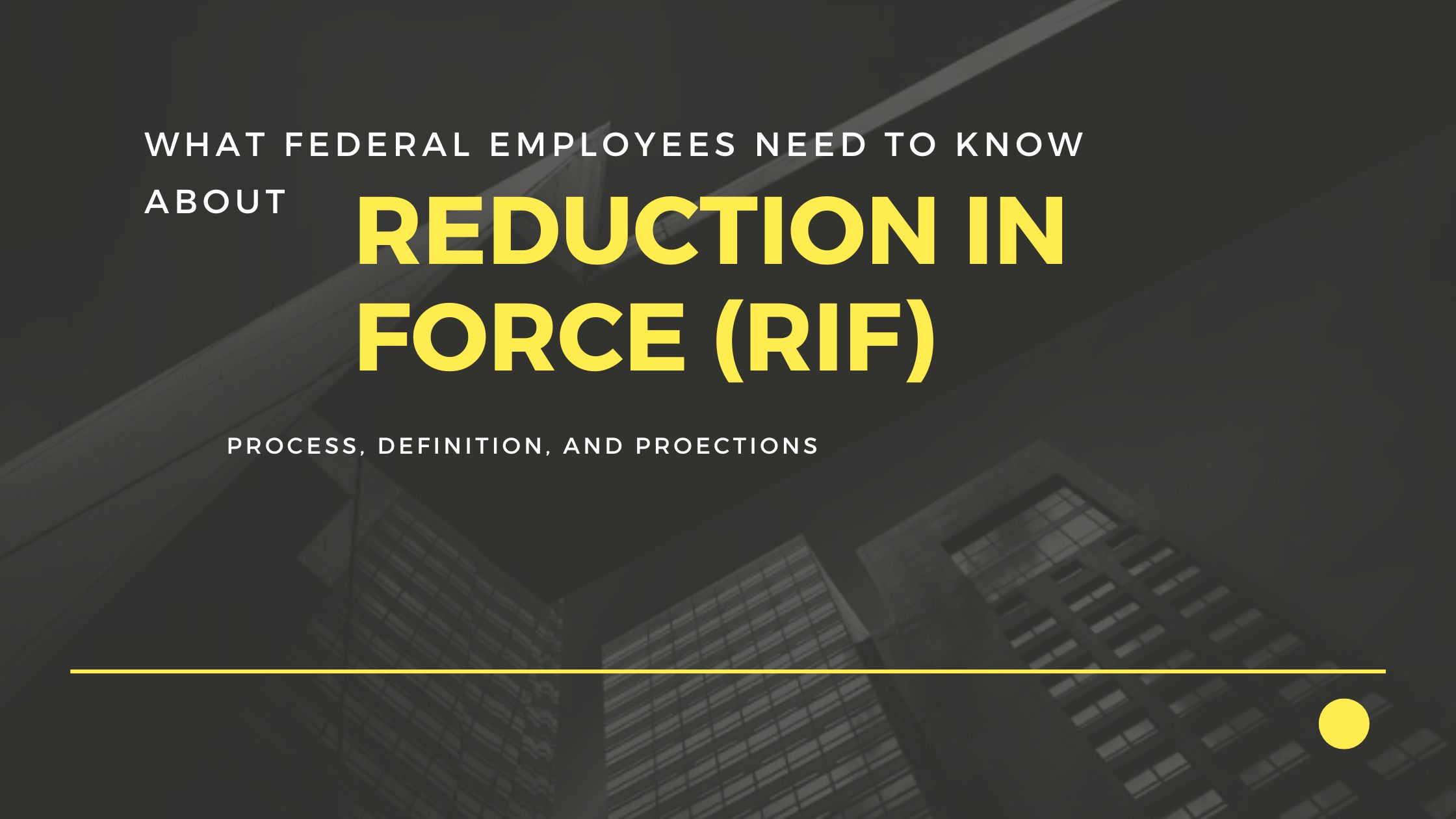Discover what a reduction in force (RIF) means for federal employees, including insights on layoffs, furloughs, and coping strategies during this challenging time. For additional guidance, be sure to review our Federal Employees: Know Your Rights During a RIF (Reduction in Force) resource.
Federal Agency Reduction in Force: Key Insights and Policies
In the current complex landscape of federal employment, understanding the intricacies of a Reduction in Force (RIF) is crucial for both employees and agencies. A RIF is a formal process used by federal agencies to reduce their workforce due to budget constraints, reorganization, or other factors. This article will explore the key aspects of an RIF, including its definition, how the process works in the federal government, and the impact on federal employees, particularly concerning health benefits and severance pay. Find out what an RIF entails and how it compares to other workforce reduction strategies like furloughs.
What is a Reduction in Force (RIF) at a Federal Agency?
Is an RIF Different from a Layoff?
A Reduction-in-Force (RIF) in the federal government context is distinct from a layoff in the private sector. While both involve workforce reductions, a RIF is governed by specific legal requirements and policies outlined in the Code of Federal Regulations. Unlike layoffs, which can be more abrupt and less regulated, an RIF involves a structured process where federal employees are ranked based on tenure, performance, and other factors. This process determines who will be separated by RIF, ensuring that decisions are made fairly and transparently. The RIF process also includes provisions for pay retention and career transition assistance plans, which are not typically available in private sector layoffs.
What Triggers a Reduction in Force?
Several factors can trigger a Reduction in Force within federal agencies. A primary reason is a lack of work or funding, which necessitates a reevaluation of the workforce size. Additionally, organizational changes such as restructuring or the introduction of new technologies can lead to a RIF. The decision to implement a RIF is not taken lightly and involves a thorough analysis of whether a RIF is necessary. Federal agencies must consider the number of employees affected, the effective date of the RIF, and the potential impact on operations.
Here are the main triggers for an RIF:
- Agency assessment – leaders at agency identify positions that can be cut without disrupting essential functions.
- Restructuring/Reorganization – process initiated by agency leaders, who must properly follow the RIF regulations
- Budgetary Constraints – the federal government’s budget is determined by Congress and requires the president’s signature, otherwise there is a shutdown.
- Program Elimination/Reduction – also requires action from Congress and the White House’s approval. Positions involved with the program are eliminated.
- Technological Advancement – technology emerges that can replace human workforce to “streamline” and “automate” agency operations.
- Declining Workload – agency has experienced significant drop in work needed to be performed for government duties.
Are you ready for retirement? Learn about the TSP, FERS, Social Security, and more at our free online federal retirement workshop.
How Does a Lack of Work Influence RIF Decisions?
A lack of work is a common factor influencing RIF decisions within federal agencies. When there is insufficient work to justify the current workforce size, agencies may opt for a RIF to realign their resources. This decision is based on a comprehensive analysis of the agency’s operational needs and budget constraints. The goal is to ensure that the workforce is appropriately sized to meet the agency’s mission and objectives. Employees should be aware of how a lack of work can impact RIF decisions and the potential implications for their employment.
What Are the Legal Requirements for an RIF?
What Policies Govern a Reduction in Force?
The policies governing a federal Reduction in Force are detailed in the Code of Federal Regulations and other government directives. These policies establish the framework for conducting an RIF, including the criteria for employee retention, the order of separation, and the rights of affected employees. Federal agencies must adhere to these guidelines to ensure that the RIF process is conducted legally and ethically. The policies also outline the procedures for notifying employees, providing them with a summary of the reduction in force, and offering support through career transition assistance plans. Compliance with these policies is essential to protect the rights of federal employees and maintain the integrity of the RIF process.
How Are Federal Civilian Employees Notified of an RIF?
Notification is a critical component of the RIF process. Federal employees are informed of a RIF when their employing agency issues RIF notices that provides details about the impending workforce reduction. This notice includes information on the effective date of the RIF, the employee’s position in the retention register, and any available options for reassignment or transition. The notification process is designed to give employees ample time to prepare for the changes and explore alternative employment opportunities. Additionally, agencies may offer workshops and counseling services to assist employees in navigating the process and planning their next steps.
Need to speak with an expert in federal employee retirement benefits? Set up a conversation with a PlanWell Advisor to get individualized guidance.
What Legal Protections Exist for Federal Employees?
Federal employees affected by a RIF are entitled to several legal protections. These include the right to appeal the RIF action to the MSPB (Merit Systems Protection Board) if they believe it was not conducted in accordance with established policies. Employees may also be eligible for pay retention if they accept a lower-grade position as a result of the RIF. Furthermore, the government provides resources such as the Career Transition Assistance Plan to support employees in finding new employment. These protections are designed to mitigate the impact of a RIF and ensure that employees are treated fairly throughout the process. Additionally, unionized employees might have more rights under the RIF regulations, depending on their collective bargaining agreement (CBA), similar to how CBAs protected some employees from the recent executive order to end remote work.
How Does a RIF Impact Federal Employees’ Health Benefits?
What Happens to Federal Employees’ Health Benefits During a RIF?
During a RIF, federal employees may have concerns about the status of their health benefits. Generally, employees who are separated by RIF can continue their health coverage under the Federal Employees Health Benefits (FEHB) program for a limited time. The continuation of benefits is subject to certain conditions, such as the employee’s enrollment status at the time of separation. Employees are encouraged to review their health benefits options and make informed decisions about their coverage during this transitional period.
Can Federal Employees Continue Their Health Benefits Post-RIF?
Federal employees who are separated by RIF have the option to continue their health benefits through the Temporary Continuation of Coverage (TCC) program. TCC allows former employees to maintain their FEHB coverage for up to 18 months, although they are responsible for paying the full premium, including the government’s share. This option provides a safety net for employees as they transition to new employment or other health coverage arrangements. Understanding the terms and costs associated with TCC is essential for employees to make informed decisions about their health benefits post-RIF.
What Severance and Unemployment Benefits Are Available?
Do Federal Employees Receive Severance Pay?
Federal employees who are separated by RIF might be eligible to receive severance pay, depending on their length of service and other factors. Severance pay is intended to provide financial support during the transition to new employment. Eligibility for severance pay is determined by age and service requirements, and the amount is calculated based on the employee’s basic pay and years of service. Employees should review the specific criteria for severance pay to understand their entitlements and plan accordingly.
How Can Federal Employees Apply for Unemployment Insurance?
Federal employees affected by a RIF can apply for unemployment insurance to receive temporary financial assistance while they search for new employment. The process for applying for unemployment insurance varies by state, but generally involves submitting an application and providing documentation of the RIF separation. Employees should familiarize themselves with the unemployment insurance requirements in their state and ensure they meet the eligibility criteria. Timely application and accurate documentation are key to receiving benefits without delay.
Involuntary Separation: How Does a RIF Compare to a Furlough?
What is the Difference Between a RIF and a Furlough?
While both a RIF and a furlough involve workforce reductions, they differ significantly in their implementation and impact. A RIF results in permanent separation from employment, whereas a furlough is a temporary, unpaid leave of absence. Furloughs are often used as a cost-saving measure during budget shortfalls, allowing employees to return to work once the financial situation improves. In contrast, a RIF is a more permanent solution to address a lack of work or funding. Understanding these differences is crucial for federal employees to navigate their options and plan for the future.
What Are the Long-term Implications of a RIF vs. a Furlough?
The long-term implications of a RIF versus a furlough can vary significantly for federal employees. A RIF often leads to permanent job loss, requiring employees to seek new employment opportunities or consider retirement options if they meet the age and service requirements. In contrast, a furlough is temporary, allowing employees to retain their positions and benefits while the agency addresses its financial challenges. However, repeated furloughs can lead to financial instability and uncertainty for employees. Understanding these implications can help employees make informed decisions about their career paths and financial planning.
Reach Out to Us!
If you have additional federal benefit questions, contact our team of CERTIFIED FINANCIAL PLANNER™ (CFP®), Chartered Federal Employee Benefits Consultants (ChFEBC℠), and AIF® professionals. At PlanWell, we are federal employee financial advisors with a focus on retirement planning. Learn more about our process designed for the career fed.
Preparing for federal retirement? Check out our scheduled federal retirement workshops. Sign up for our no-cost federal retirement webinars through this page. Make sure to plan ahead and reserve your seat for our FERS webinar, held every three weeks. Want to have PlanWell host a federal retirement seminar for your agency? Reach out, and we’ll collaborate with HR to arrange an on-site FERS seminar.
Want to fast-track your federal retirement plan? Skip the FERS webinar and start a one-on-one conversation with a ChFEBC today. You can schedule a one-on-one meeting using this form.










